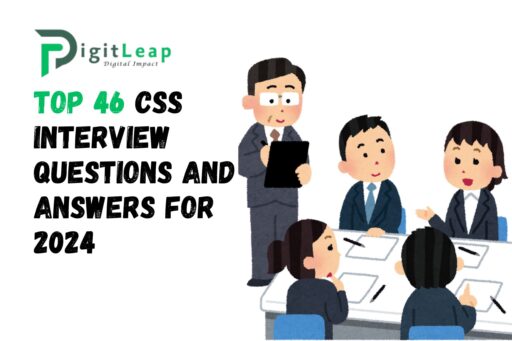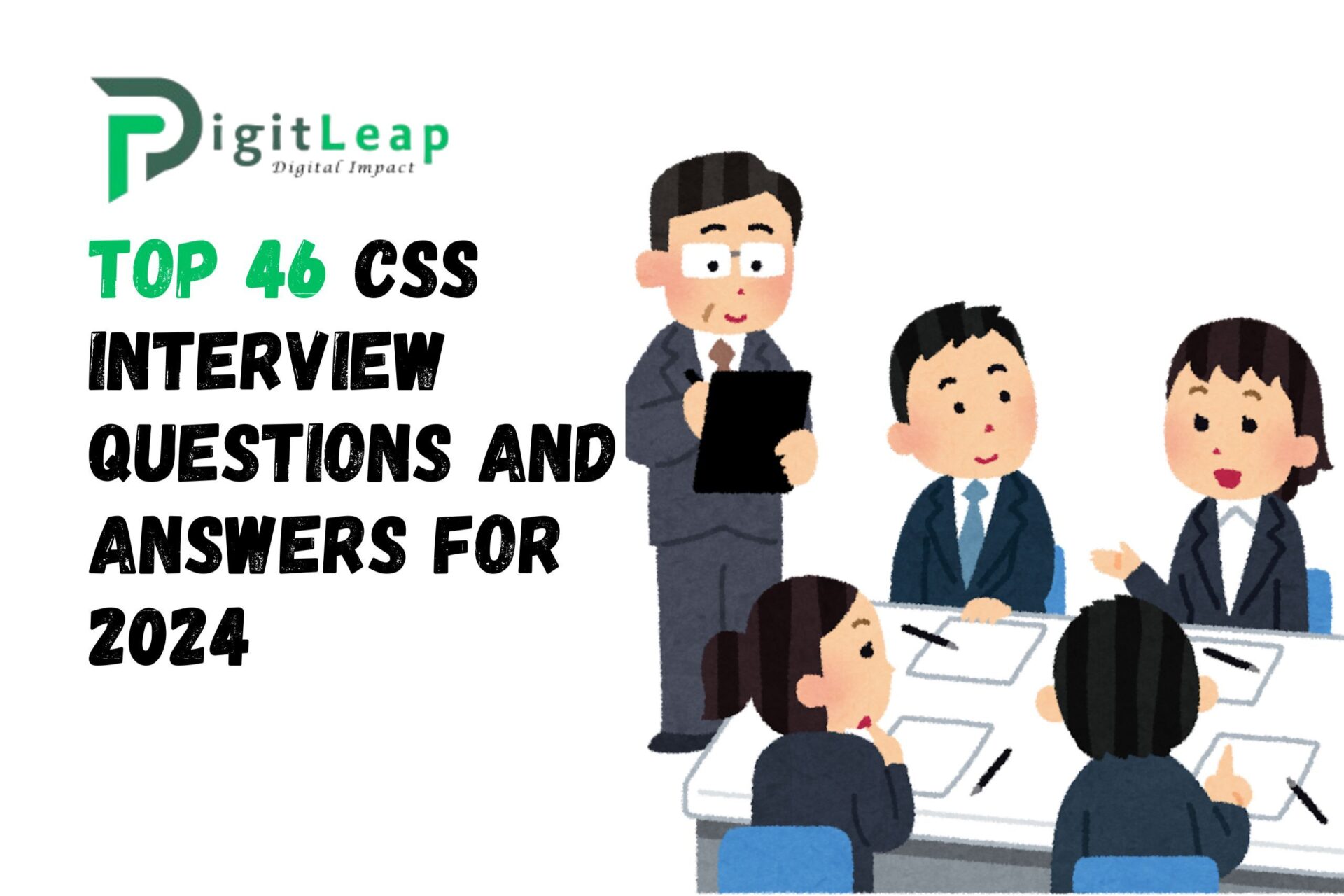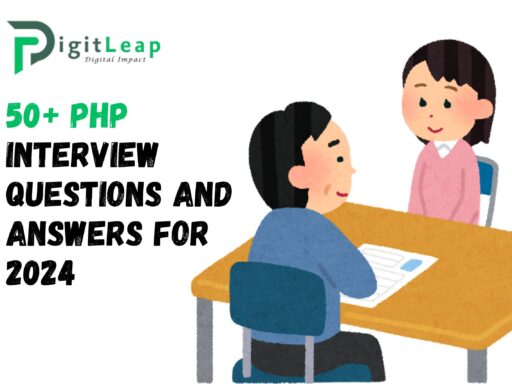Top 46 CSS Interview Questions and Answers for 2024
Here’s a collection of essential CSS interview questions and answers for 2024. Whether you’re a fresher or an experienced developer, this guide will help you prepare for your next CSS interview.
1. What is CSS?
Answer: CSS stands for Cascading Style Sheets. It is a stylesheet language used to describe the presentation of a document written in HTML or XML. CSS controls the layout, colors, fonts, and overall visual appearance of web pages.
2. What are the different ways to apply CSS to a web page?
Answer: CSS can be applied in three ways:
- Inline CSS: Using the
styleattribute directly within an HTML element. - Internal CSS: Including CSS rules within the
<style>tag in the<head>section of an HTML document. - External CSS: Linking to a separate CSS file using the
<link>tag in the<head>section of an HTML document.
3. What is the CSS Box Model?
Answer: The CSS Box Model describes how elements are structured and spaced on a web page. It consists of:
- Content: The actual content of the box, such as text or images.
- Padding: Space between the content and the border.
- Border: A border surrounding the padding and content.
- Margin: Space outside the border, separating the element from other elements.
4. What are CSS Selectors?
Answer: CSS selectors are patterns used to select elements on a web page to apply styles. Examples include:
- Element Selector:
p(selects all<p>elements) - Class Selector:
.class-name(selects all elements with the specified class) - ID Selector:
#id-name(selects the element with the specified ID) - Attribute Selector:
[type="text"](selects elements with the specified attribute)
5. What is the difference between class and id in CSS?
Answer:
- Class: Used to apply styles to multiple elements. It is defined with a period (
.) in CSS and is reusable. - ID: Used to apply styles to a single unique element. It is defined with a hash (
#) in CSS and should be unique within the page.
6. How do you create a CSS Grid Layout?
Answer: To create a CSS Grid Layout, use the display: grid; property on a container element. Define rows and columns with properties like grid-template-rows and grid-template-columns, and place items within the grid using grid lines or areas.
cssCopy code.container {
display: grid;
grid-template-columns: 1fr 2fr;
grid-template-rows: auto;
}
.item {
grid-column: 1 / 3;
}
7. What is Flexbox and how is it used?
Answer: Flexbox (Flexible Box Layout) is a CSS layout module designed to distribute space along a single axis (horizontal or vertical). To use Flexbox, set display: flex; on a container element. Flex properties such as justify-content, align-items, and flex-direction are used to control the layout and alignment of items.
cssCopy code.container {
display: flex;
justify-content: space-between;
align-items: center;
}
8. What are media queries in CSS?
Answer: Media queries are used to apply CSS styles based on the characteristics of the viewport, such as its width, height, or device type. They are essential for creating responsive designs.
cssCopy code@media (max-width: 600px) {
.container {
flex-direction: column;
}
}
9. What is the z-index property?
Answer: The z-index property controls the stacking order of positioned elements (those with position set to relative, absolute, or fixed). Higher z-index values place elements on top of those with lower values.
10. How do you center a block element horizontally?
Answer: To center a block element horizontally, set its margin property to auto and ensure the element has a defined width:
cssCopy code.block {
width: 50%;
margin: 0 auto;
}
11. What are pseudo-classes in CSS?
Answer: Pseudo-classes are keywords added to selectors that specify a special state of an element. Examples include:
:hover– Applies styles when the user hovers over an element.:focus– Applies styles when an element receives focus.:nth-child(n)– Selects elements based on their position in a parent element.
12. What is the box-sizing property?
Answer: The box-sizing property defines how the total width and height of an element are calculated. The border-box value includes padding and border in the element’s total width and height, making layout calculations easier.
cssCopy code.element {
box-sizing: border-box;
}
13. How do you apply styles to child elements in CSS?
Answer: To apply styles to child elements, use descendant selectors:
cssCopy code.parent .child {
color: blue;
}
14. What is the difference between absolute, relative, fixed, and sticky positioning?
Answer:
absolute: Positions an element relative to its nearest positioned ancestor.relative: Positions an element relative to its normal position.fixed: Positions an element relative to the viewport and does not move when scrolling.sticky: Positions an element based on the user’s scroll position, toggling between relative and fixed positioning.
15. How do you use @keyframes for animations?
Answer: The @keyframes rule is used to define animations by specifying the styles for different stages of the animation. Apply the animation to an element using the animation property.
cssCopy code@keyframes slide {
from { transform: translateX(-100%); }
to { transform: translateX(0); }
}
.element {
animation: slide 2s ease-in-out;
}
16. What is the opacity property?
Answer: The opacity property sets the transparency level of an element. Values range from 0 (completely transparent) to 1 (completely opaque).
cssCopy code.element {
opacity: 0.5;
}
17. What is the transition property?
Answer: The transition property allows you to change property values smoothly over a specified duration. It requires specifying the property to transition, the duration, and optionally the timing function.
cssCopy code.element {
transition: background-color 0.3s ease;
}
18. How do you create a CSS gradient?
Answer: Use the background property with the linear-gradient or radial-gradient function:
cssCopy code.element {
background: linear-gradient(to right, red, yellow);
}
19. What is the :root pseudo-class?
Answer: The :root pseudo-class represents the highest-level parent of the document, typically the <html> element. It is often used for defining CSS variables.
cssCopy code:root {
--main-color: blue;
}
.element {
color: var(--main-color);
}
20. How do you hide an element without removing it from the document flow?
Answer: Use the visibility property with the value hidden:
cssCopy code.element {
visibility: hidden;
}
21. What is a CSS preprocessor?
Answer: A CSS preprocessor extends CSS with features like variables, nested rules, and mixins. Examples include Sass, Less, and Stylus. They require compilation into standard CSS before being used on a web page.
22. What is the flex property?
Answer: The flex property is a shorthand for flex-grow, flex-shrink, and flex-basis. It defines how a flex item grows and shrinks within a flex container.
cssCopy code.item {
flex: 1 1 200px;
}
23. How do you make a layout responsive?
Answer: Use responsive design techniques like media queries, fluid grids, and flexible images. Ensure your design adapts to various screen sizes and orientations.
24. What is rem and em in CSS?
Answer:
rem: Relative to the root element’s font size.em: Relative to the font size of the parent element.
25. How do you create a CSS triangle?
Answer: Create a CSS triangle by setting the border of a zero-width, zero-height element. The color of one of the borders will create the triangle effect.
cssCopy code.triangle {
width: 0;
height: 0;
border-left: 50px solid transparent;
border-right: 50px solid transparent;
border-bottom: 50px solid blue;
}
26. What is the calc() function in CSS?
Answer: The calc() function allows you to perform calculations to determine CSS property values. It can be used to combine units or perform arithmetic operations.
cssCopy code.element {
width: calc(100% - 20px);
}
27. How do you style placeholder text in an input field?
Answer: Use the ::placeholder pseudo-element to style placeholder text:
cssCopy codeinput::placeholder {
color: gray;
font-style: italic;
}
28. What is the transform property?
Answer: The transform property applies a 2D or 3D transformation to an element, such as rotating, scaling, or translating.
cssCopy code.element {
transform: rotate(45deg);
}
29. How do you create a fixed header that stays on top of the page?
Answer: Use the position: fixed; property with top: 0;:
cssCopy code.header {
position: fixed;
top: 0;
width: 100%;
}
30. What are CSS Variables?
Answer: CSS Variables, or custom properties, allow you to define reusable values that can be accessed throughout your CSS. They are defined within a :root selector and accessed using the var() function.
cssCopy code:root {
--main-bg-color: lightblue;
}
.element {
background-color: var(--main-bg-color);
}
31. What is the background-clip property?
Answer: The background-clip property specifies the area within which the background color or image is painted. It can take values like border-box, padding-box, or content-box.
32. How do you create a CSS-only accordion?
Answer: Use the :checked pseudo-class with hidden radio buttons or checkboxes to control the visibility of accordion panels. Use + combinators to style the corresponding content.
htmlCopy code<input type="checkbox" id="section1">
<label for="section1">Section 1</label>
<div class="content">
<p>Accordion content here.</p>
</div>
cssCopy code.content {
display: none;
}
#section1:checked + .content {
display: block;
}
33. How do you use :nth-of-type?
Answer: The :nth-of-type pseudo-class selects elements of a specific type based on their position within their parent element.
cssCopy codep:nth-of-type(2) {
color: red;
}
34. What is the pointer-events property?
Answer: The pointer-events property controls under what circumstances an element can become the target of mouse events. For example, pointer-events: none; makes an element ignore mouse events.
35. How do you use CSS to style visited and unvisited links differently?
Answer: Use the :visited and :link pseudo-classes to style links based on their state.
cssCopy codea:link {
color: blue;
}
a:visited {
color: purple;
}
36. What is the clip-path property?
Answer: The clip-path property creates a clipping region to define which parts of an element are visible. It can take values like circle(), ellipse(), and polygon().
37. How do you implement a CSS animation delay?
Answer: Use the animation-delay property to specify a delay before the animation starts.
cssCopy code.element {
animation: slide 2s ease-in-out;
animation-delay: 1s;
}
38. What is the difference between inline and block display properties?
Answer:
inline: Elements flow along with the text and only take up as much width as necessary.block: Elements start on a new line and take up the full width available.
39. How do you add a shadow to an element in CSS?
Answer: Use the box-shadow property for element shadows and text-shadow for text shadows.
cssCopy code.element {
box-shadow: 2px 2px 5px gray;
}
.text {
text-shadow: 1px 1px 3px black;
}
40. What are @supports rules?
Answer: The @supports rule is used to apply CSS styles based on whether a browser supports certain CSS features.
cssCopy code@supports (display: grid) {
.container {
display: grid;
}
}
41. How do you handle browser compatibility issues in CSS?
Answer: Use vendor prefixes for experimental features, and provide fallbacks or alternative styles for older browsers. Utilize feature detection libraries like Modernizr.
42. What is the visibility property and how does it differ from display?
Answer:
visibility: Hides an element but keeps its space in the layout (visibility: hidden;).display: Removes an element from the layout entirely (display: none;).
43. How do you set different styles for different screen sizes?
Answer: Use media queries to apply different styles based on screen size or other characteristics.
cssCopy code@media (max-width: 768px) {
.element {
background-color: lightgray;
}
}
44. What are ::before and ::after pseudo-elements?
Answer: The ::before and ::after pseudo-elements are used to insert content before or after an element’s actual content. They are often used for decorative purposes.
cssCopy code.element::before {
content: "Prefix - ";
}
45. What is the will-change property?
Answer: The will-change property informs the browser of upcoming changes to an element, allowing it to optimize performance. It takes values like transform, opacity, and scroll-position.
46. How do you use object-fit in CSS?
Answer: The object-fit property specifies how the content of a replaced element (like an image or video) should be resized to fit its container.
cssCopy codeimg {
object-fit: cover;
}
Download the Full PDF
For a complete study guide, download the full list of CSS interview questions and answers as a PDF here.
Other Important Q&A List :
- OOPs Interview Questions And Answers
- SQL Interview Questions and Answers
- Content Writing Interview Questions and Answers
- Email Marketing Interview Questions and Answers
- Django Interview Questions and Answers
- C Programming Interview Questions and Answers
- ReactJS Interview Questions and Answers
- Angular Interview Questions and Answers
- Power BI Interview Questions and Answers
- Top DBMS Interview Questions and Answers
- Python Interview Questions and Answers
- MySQL Interview Questions and Answers
- Java Interview Questions and Answers
- Data Structures Interview Questions
- Flutter Interview Questions and Answers
- JavaScript Interview Questions and Answers
- PHP Interview Questions and Answers
- CSS Interview Questions and Answers
- HTML Interview Questions and Answers






